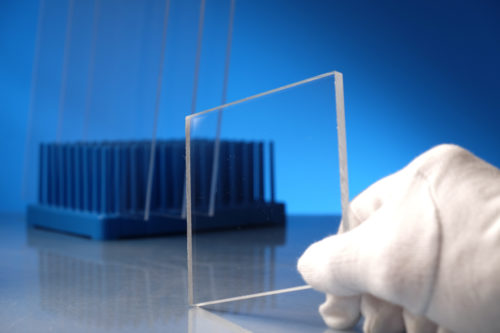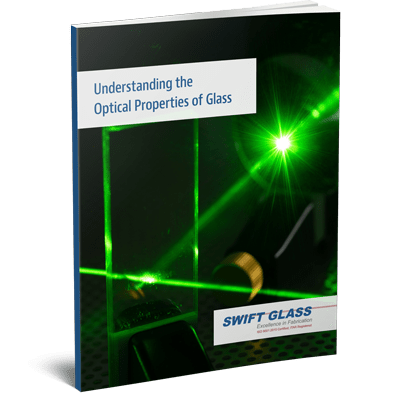From magnifying glasses to tinted windows to one-way mirrors, people prize glass for its ability to transmit (or not transmit) light.
Measuring light transmission and transmittance plays a huge role in selecting an appropriate type of glass for your needs. Transmittance measures the amount of light able to pass through a material without the material reflecting or absorbing it. Therefore, transparent glass will transmit 100% of light, translucent material only allows some light to come through, and opaque glass will achieve close to 0% transmittance.
A few key differences exist between light transmission and transmittance. Understanding the distinction between these two terms will help you select the perfect type of glass for your application.
Transmission vs. Transmittance
 Transmission refers to the amount of incident light that successfully passes through glass or other material, and it’s usually expressed as a percentage of light that made it through the material. On the other hand, transmittance refers to the amount of light that a material disperses, effectively resulting in an inverse value of that found for transmission.
Transmission refers to the amount of incident light that successfully passes through glass or other material, and it’s usually expressed as a percentage of light that made it through the material. On the other hand, transmittance refers to the amount of light that a material disperses, effectively resulting in an inverse value of that found for transmission.
There are two basic types of transmission—external and internal—and both differ from light transmittance:
- External transmission is calculated from the intensity of the incident light as it enters the glass versus the light’s intensity after exiting the glass. This transmission measurement technique provides an accurate figure of the actual amount of light allowed to pass through a material.
- Internal transmission is determined by the light’s intensity once it has entered the glass versus its intensity after it leaves the glass. Internal transmission primarily measures the light filtration ability of the glass itself, allowing you to get a more accurate idea of the glass’s properties.
- Transmittance refers to the amount of light energy that the glass absorbs, scatters, or reflects. It’s measured using the formula T = I/I0, with T denoting the transmission intensity, I indicating intensity, and I0 indicating intensity at the start. This calculation allows you to determine the ratio of transmitted radiant power to incident radiant power, giving a greater idea of a glass’s ability to block photons.
How Does Transmittance Apply to My Application?
Transmittance values can vary based on which application or common industry nomenclature they use.
For example, while most manufacturers measure industrial glasses in terms of external transmittance, they usually measure filter glasses in internal transmittance. This is because manufacturers can put an anti-reflective (AR) coating on the glass’s surface, reducing the amount of light intensity lost to reflection.
A couple of common applications that measure transmission include:
- Testing window tint or films for cars, homes, and businesses. Desired tint levels will correspond with the amount of light the glass transmits.
- Measuring glass clarity. Many industries have stringent specifications governing the use of glass in assembly regarding both external or internal transmission. For instance, FAA specifications for airport and aerospace applications typically govern the product’s external transmission potential.
It’s also good to keep in mind that engineers who design optics for extreme environments must recognize that each type of glass will have slight variations in chemical, thermal, and mechanical properties, all of which factor into their ability to reflect and absorb light.
Glass for All Occasions at Swift Glass
 At Swift Glass, we pride ourselves on having delivered industry-leading custom glass manufacturing services for almost 100 years to OEMs across the country. Our experience and dedication to customer success enables us to understand our customers’ intricate needs and exceed their expectations.
At Swift Glass, we pride ourselves on having delivered industry-leading custom glass manufacturing services for almost 100 years to OEMs across the country. Our experience and dedication to customer success enables us to understand our customers’ intricate needs and exceed their expectations.
We’re an ITAR-registered, ISO 9001:2015–certified company and a worldwide leader in fabricated glass parts. We offer holistic assistance in glass crafting, material selection, and custom design, maintaining a high standard of precision and quality.
To learn more about the optical properties of glass, download our latest eBook here, and don’t hesitate to contact us today if you have any questions.




